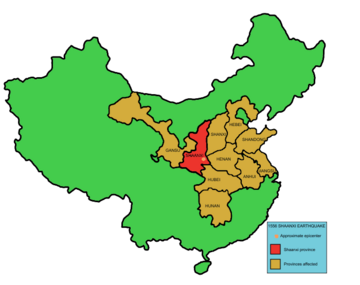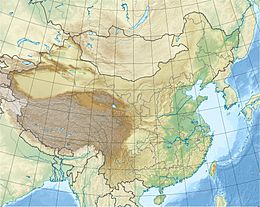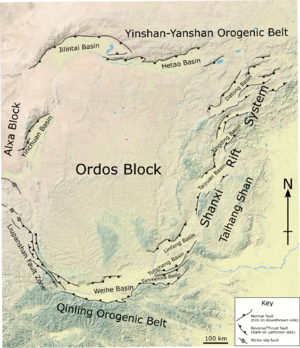1556 Shaanxi earthquake facts for kids

Map of China showing modern-day Shaanxi province (red) and the other provinces affected by the earthquake (orange)
|
|
| Local date | 23 January 1556 in Julian calendar 2 February 1556 in Gregorian calendar The 12th day of the 12th month of the 34th year of the Jiajing era in Chinese calendar |
|---|---|
| Local time | Early morning |
| Magnitude | 7.0–7.5 Mw, 8.0 Mw |
| Depth | Unknown |
| Epicenter | 34°30′01″N 109°18′00″E / 34.50028°N 109.30000°E |
| Areas affected | Ming dynasty |
| Max. intensity | XI (Extreme) |
| Casualties |
|
The 1556 Shaanxi earthquake was a massive natural disaster. It happened in the early morning of February 2, 1556. This powerful earthquake struck the Shaanxi province in China. At that time, China was ruled by the Ming dynasty. People in China often call it the Jiajing Great Earthquake. This is because it happened during the reign of the Jiajing Emperor.
Many people in the affected area lived in homes called yaodongs. These were special caves dug into soft cliffs. When the earthquake hit, these cave homes collapsed. Sadly, many people were trapped inside. Experts believe about 100,000 people died directly from the shaking. Over 700,000 more people either moved away or died later. This was due to problems like lack of food and sickness that followed the earthquake. In total, about 830,000 people were affected. This makes it one of the deadliest earthquakes and natural disasters in all of Chinese history.
Contents
Why Earthquakes Happen Here
The area where the earthquake struck, called Huaxian, is in a place known as the Weihe Basin. This basin is part of a larger system of valleys. These valleys are formed by cracks in the Earth's crust. These cracks are called faults.
Imagine the Earth's surface as a giant puzzle made of huge pieces called tectonic plates. These plates are always moving, very slowly. Sometimes, these plates pull apart or slide past each other. This movement causes stress to build up along the faults.
When the stress becomes too much, the rocks suddenly slip. This sudden movement releases a lot of energy. This energy travels through the ground as seismic waves, which we feel as an earthquake. The Weihe Basin has many large faults. These faults have caused many big earthquakes throughout history.
The Day the Earth Shook
The main point where the earthquake started deep underground is called the epicenter. For this earthquake, the epicenter was in the Wei River Valley. This is in Shaanxi Province, near cities like Huaxian, Weinan, and Huayin.
The city of Huaxian was almost completely destroyed. More than half of its people died. The cities of Weinan and Huayin also suffered terrible damage. In some places, the ground cracked open, forming deep gaps up to 20 meters (about 65 feet) deep.
The destruction spread far and wide. Areas up to 500 kilometers (about 310 miles) away felt the shaking. The earthquake also caused landslides. These landslides buried homes and added to the huge number of deaths.
Historical Records of the Disaster
Because this earthquake happened when the Jiajing Emperor ruled, it is often called the Jiajing Great Earthquake in Chinese history books.
Ancient Chinese records describe the event like this:
In the winter of 1556, a terrible earthquake hit Shaanxi and Shanxi Provinces. In our Hua County, many bad things happened. Mountains and rivers seemed to change places. Roads were destroyed. In some areas, the ground suddenly rose up, making new hills. In other places, it sank down, creating new valleys. Sometimes, a stream would suddenly appear. Or the ground would break, forming new ditches. Homes, government buildings, temples, and city walls all collapsed very quickly.
The earthquake also damaged many ancient stone tablets. These tablets were part of a collection called the Stele Forest. Out of 114 important stone classics, 40 were broken.
A scholar named Qin Keda survived the earthquake. He wrote down what he saw and learned. He advised people not to rush outside right away during an earthquake. Instead, he suggested crouching down and waiting. He meant that even if a building collapses, there might still be safe spots inside. The shaking also made the famous Small Wild Goose Pagoda in Xi'an shorter by three levels.
Measuring the Earthquake's Power
Scientists today use special scales to measure earthquakes. The 1556 Shaanxi earthquake was incredibly powerful. It is estimated to have had a magnitude of about 7.0 to 7.5. This is like comparing the energy released to many atomic bombs!
Another way to measure an earthquake is by its intensity. This scale describes how much damage it caused and how strongly people felt it. The Shaanxi earthquake had an intensity of XI. This means it caused "catastrophic damage."
After the main earthquake, smaller tremors called aftershocks continued. These aftershocks happened several times a month for about six months.
Evidence in the Earth
The shaking was strongest in the Weihe Basin, especially in Huaxian and Weinan. This suggests that the earthquake happened along major cracks in the Earth's crust, called faults. Scientists have found evidence of these faults. They see places where the ground moved up or down, creating "scarps" or steps in the land. Some of these steps were as high as 8 meters (about 26 feet).
These scarps show how much the Earth's surface shifted during the earthquake. Studies have looked at these changes. They help scientists understand how powerful the earthquake truly was. They also help us learn more about how earthquakes happen in this region.
How Far Did the Damage Spread?
The earthquake affected a huge area. More than 97 different regions, called counties, felt its power. These counties were spread across many provinces in China. Some of these provinces include Shaanxi, Shanxi, Henan, and Gansu.
Even far-off cities like Beijing, Chengdu, and Shanghai felt some shaking. Their buildings had slight damage. The main area of destruction was about 840 kilometers (about 520 miles) wide. In some places, a shocking 60% of the people living there died. It's almost impossible to imagine the total cost of all the damage today.
The Tragic Number of Lives Lost
The 1556 Shaanxi earthquake caused a terrible loss of life. Experts believe about 100,000 people died directly from the earthquake's shaking. But the disaster's impact didn't stop there. Over 730,000 more people were affected. They either moved away from the damaged areas or died later. This was due to problems like a lack of food and widespread sickness that followed the earthquake.
In total, the population in the affected region dropped by about 830,000 people. This makes it one of the deadliest earthquakes ever recorded in China. It is also one of the worst natural disasters in Chinese history.
Why So Many Died
A big reason for the high death toll was the type of homes people lived in. Millions of people in the area lived in yaodongs. These were homes dug into the soft cliffs of the Loess Plateau.
When the earthquake struck, these cave homes were very fragile. Many of them collapsed instantly. This trapped and buried the people inside. The earthquake also caused many landslides. These landslides destroyed even more homes and added to the tragic number of deaths.
How Others Heard About It
News of the powerful earthquake even reached people far away. A Portuguese friar named Gaspar da Cruz visited China later in 1556. He heard stories about the earthquake. He later wrote about it in his book, A Treatise of China.
In his book, he shared how some people at the time tried to understand such a huge disaster. He mentioned that some believed it might be a sign or a warning. He also connected it to the appearance of a large comet seen that year. This shows how people in the past tried to make sense of major natural events.
See also
 In Spanish: Terremoto de Shaanxi de 1556 para niños
In Spanish: Terremoto de Shaanxi de 1556 para niños
- List of earthquakes in China
- List of disasters in China by death toll
- List of historical earthquakes



